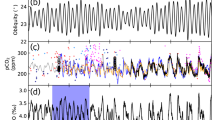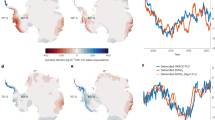Abstract
Variations in the eccentricity (100,000 yr), obliquity (41,000 yr) and precession (23,000 yr) of Earth’s orbit have been linked to glacial–interglacial climate cycles. It is generally thought that the 100,000-yr glacial cycles of the past 800,000 yr are a result of orbital eccentricity1,2,3,4. However, the eccentricity cycle produces negligible 100-kyr power in seasonal or mean annual insolation, although it does modulate the amplitude of the precession cycle. Alternatively, it has been suggested that the recent glacial cycles are driven purely by the obliquity cycle5,6,7. Here I use statistical analyses of insolation and the climate of the past five million years to characterize the link between eccentricity and the 100,000-yr glacial cycles. Using cross-wavelet phase analysis, I show that the relative phase of eccentricity and glacial cycles has been stable since 1.2 Myr ago, supporting the hypothesis that 100,000-yr glacial cycles are paced8,9,10 by eccentricity4,11. However, I find that the time-dependent 100,000-yr power of eccentricity has been anticorrelated with that of climate since 5 Myr ago, with strong eccentricity forcing associated with weaker power in the 100,000-yr glacial cycle. I propose that the anticorrelation arises from the strong precession forcing associated with strong eccentricity forcing, which disrupts the internal climate feedbacks that drive the 100,000-yr glacial cycle. This supports the hypothesis that internally driven climate feedbacks are the source of the 100,000-yr climate variations12.
This is a preview of subscription content, access via your institution
Access options



Similar content being viewed by others
References
Hays, J. D., Imbrie, J. & Shackleton, N. J. Variations in the Earth’s orbit: Pacemaker of the ice ages. Science 194, 1121–1132 (1976).
Imbrie, J. et al. On the structure and origin of major glaciation cycles 2. The 100,000-year cycle. Paleoceanography 8, 699–735 (1993).
Clemens, S. C. & Tiedemann, R. Eccentricity forcing of Pliocene-early Pleistocene climate revealed in a marine oxygen-isotope record. Nature 385, 801–804 (1997).
Raymo, M. E. The timing of major terminations. Paleoceanography 12, 577–585 (1997).
Huybers, P. & Wunsch, C. Obliquity pacing of the late Pleistocene glacial terminations. Nature 434, 491–494 (2005).
Huybers, P. Glacial variability over the last two million years: An extended depth-derived agemodel, continuous obliquity pacing, and the Pleistocene progression. Quat. Sci. Rev. 26, 37–55 (2007).
Liu, Z., Cleaveland, L. C. & Herbert, T. D. Early onset and origin of 100-kyr cycles in Pleistocene tropical SST records. Earth Planet. Sci. Lett. 265, 703–715 (2008).
Saltzman, B., Hansen, A. & Maasch, K. The late Quaternary glaciations as the response of a three-component feedback system to Earth-orbital forcing. J. Atmos. Sci. 41, 3380–3389 (1984).
Gildor, H. & Tziperman, E. Sea ice as the glacial cycles climate switch: Role of seasonal and orbital forcing. Paleoceanography 15, 605–615 (2000).
Tziperman, E., Raymo, M. E., Huybers, P. C. & Wunsch, C. Consequences of pacing the Pleistocene 100 kyr ice ages by nonlinear phase locking to Milankovitch forcing. Paleoceanography 21, PA4206 (2006).
Ridgwell, A. J., Watson, A. J. & Raymo, M. E. Is the spectral signature of the 100 kyr glacial cycle consistent with a Milankovitch origin? Paleoceanography 14, 437–440 (1999).
Nie, J., King, J. & Fang, X. Late Pliocene–early Pleistocene 100-ka problem. Geophys. Res. Lett. 35, L21606 (2008).
Parrenin, F. & Paillard, D. Amplitude and phase of glacial cycles from a conceptual model. Earth Planet. Sci. Lett. 214, 243–250 (2003).
Shackleton, N. J. The 100,000-year ice-age cycle identified and found to lag temperature, carbon dioxide, and orbital eccentricity. Science 289, 1897–1902 (2000).
Mudelsee, M. & Schulz, M. The mid-Pleistocene climate transition: Onset of 100 ka cycle lags ice volume build-up by 280 ka. Earth Planet. Sci. Lett. 151, 117–123 (1997).
Lisiecki, L. E. & Raymo, M. E. A Pliocene–Pleistocene stack of 57 globally distributed benthic δ18O records. Paleoceanography 20, PA1003 (2005).
Clark, P. U. et al. The middle Pleistocene transition: Characteristics, mechanisms, and implications for long-term changes in atmospheric pCO2 . Qaut. Sci. Rev. 25, 3150–3184 (2006).
Kawamura, K. et al. Northern Hemisphere forcing of climatic cycles in Antarctica over the past 360,000 years. Nature 448, 912–917 (2007).
Paillard, D. The timing of Pleistocene glaciations from a simple multiple-state climate model. Nature 391, 378–381 (1998).
Lisiecki, L. E. & Raymo, M. E. Plio-Pleistocene climate evolution: Trends and transitions in glacial cycle dynamics. Quat. Sci. Rev. 26, 56–69 (2007).
Imbrie, J. & Imbrie, J. Z. Modelling the climatic response to orbital variations. Science 207, 943–953 (1980).
Raymo, M. E., Lisiecki, L. E. & Nisancioglu, K. H. Plio-Pleistocene ice volume, Antarctic climate, and the global δ18O record. Science 313, 492–495 (2006).
Medina-Elizalde, M. & Lea, D. W. The mid-Pleistocene transition in the tropical Pacific. Science 310, 1009–1012 (2005).
Saltzman, B. & Maasch, K. A. Carbon cycle instability as a cause of the Late Pleistocene ice age oscillations: Modeling the asymmetric response. Glob. Biogeochem. Cycles 2, 177–185 (1988).
Toggweiler, J. R. Origin of the 100,000-year timescale in Antarctic temperatures and atmospheric CO2 . Paleoceanography 23, PA2211 (2008).
Cande, S. C. & Kent, D. V. Revised calibration of the geomagnetic polarity timescale for the Late Cretaceous and Cenozoic. J. Geophys. Res. 100(B4), 6093–6095 (1995).
Shackleton, N. J., Crowhurst, S., Hagelberg, T., Pisias, N. G. & Schneider, D. A. A new late Neogene time scale: Application to Leg 138 sites. Proc. Ocean Drill. Program Sci. Results 138, 73–101 (1995).
Grinsted, A., Moore, J. C. & Jevrejeva, S. Application of the cross wavelet transform and wavelet coherence to geophysical time series. Nonlinear Process. Geophys. 11, 561–566 (2004).
Upton, G. & Fingleton, B. Spatial Data Analysis by Example Vol. 2 (John Wiley, 1989).
Priestley, M. B. Wavelets and time-dependent spectral analysis. J. Time Ser. Anal. 17, 85–103 (1996).
Acknowledgements
I thank T. Herbert, D. Lea and M. Raymo for many useful discussions.
Author information
Authors and Affiliations
Corresponding author
Ethics declarations
Competing interests
The author declares no competing financial interests.
Supplementary information
Supplementary Information
Supplementary Information (PDF 410 kb)
Rights and permissions
About this article
Cite this article
Lisiecki, L. Links between eccentricity forcing and the 100,000-year glacial cycle. Nature Geosci 3, 349–352 (2010). https://doi.org/10.1038/ngeo828
Received:
Accepted:
Published:
Issue Date:
DOI: https://doi.org/10.1038/ngeo828
This article is cited by
-
Exponential feedback effects in a parametric resonance climate model
Scientific Reports (2023)
-
A gradual change is more likely to have caused the Mid-Pleistocene Transition than an abrupt event
Communications Earth & Environment (2023)
-
Late Pleistocene 100-kyr glacial cycles paced by precession forcing of summer insolation
Nature Geoscience (2023)
-
Middle Ordovician astrochronology decouples asteroid breakup from glacially-induced biotic radiations
Nature Communications (2021)
-
Development of anchialine cave habitats and karst subterranean estuaries since the last ice age
Scientific Reports (2019)



